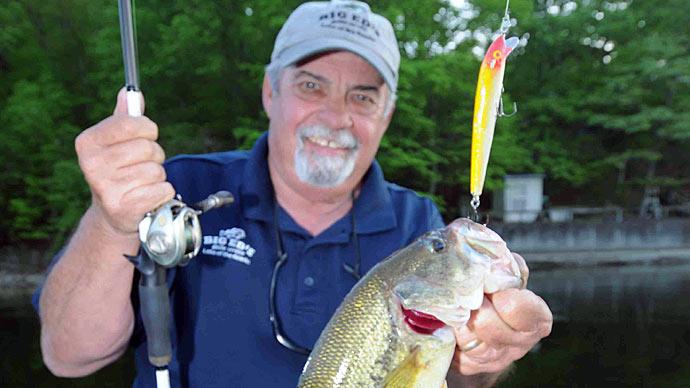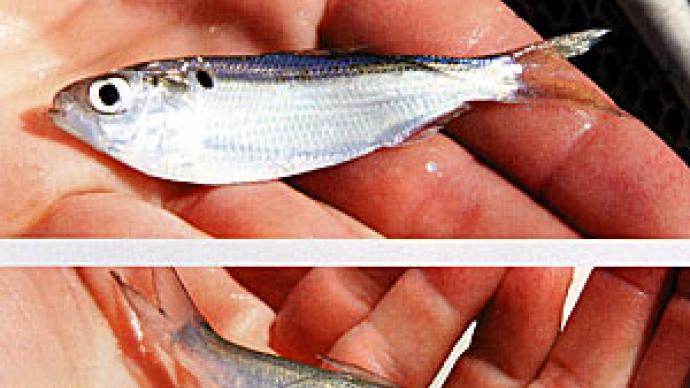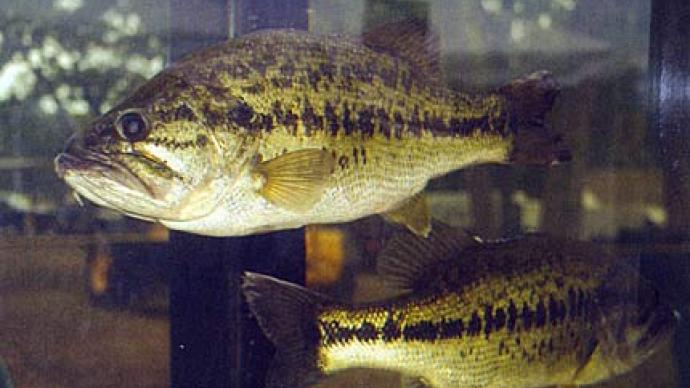In our world of private ponds and pond management, consistently producing trophy bass is an ultimate goal of many pond owners. Of course, "trophy" is in the eye of the beholder. If your daughter's first bass weighs three pounds, it's a trophy for her. For this story, define "trophy" bass as in excess of 10 pounds.
As with management of deer populations for trophy bucks, key factors for producing trophy bass are well known: age, genetics and nutrition.
In the world of ponds, the tricky part of that equation is nutrition. Genetics? No problem. Age? Bass can have all the time they need. We can easily acquire a stock of bass with desired genetics and give them adequate time to reach trophy size. All it takes is employing selective harvest and the too popular practice of catch-and-release fishing.
How can an owner of a 10 acre pond, for example, ensure his bass have enough food daily? Unfortunately, Florida and Florida X Northern bass do not eat fish feed. And, it is extremely expensive to purchase truck loads of forage fish to directly feed bass on a regular basis.
It falls to pond owners or managers to manipulate predator and prey populations to ensure bass always have adequate food. Obviously, this is not as easy as ordering a pallet of deer chow and filling feed troughs.
Don't simply believe it's enough to simply provide abundance of food. Bass don't trot up to a feed trough and graze. They chase down and capture their food. Our role is to ensure bass have appropriate size food as they grow larger. For energy bass expend chasing down and capturing prey, it must receive a large enough return on it's investment. Otherwise, there is no energy "profit." To grow at exceptionally high rates, this energetic profit must be exceptionally high.
Call this concept "maximum foraging efficiency". It is a common sense, easy to understand idea. Simply put, a large bass needs a correspondingly large prey to continue growing well.
Imagine a 6 or 8 pound bass living in a pond. Most of the time, this bass is loafing around, hiding and waiting for food or digesting a recent meal. Largemouth bass are ambush predators, not open water, cruising predators as striped bass or tuna. It is easy to understand bass spend the same amount of energy to chase and eat a 3 inch prey fish as a 10 inch prey fish. However, that 6 pound bass receives much less return from small meals compared to large ones. In fact, if your 6 pound bass does not have an ample supply of large prey, but must rely on 3 inch prey, it may run an energetic deficit and actually lose weight.
Most pond owners and pond fishermen have seen the result of this inefficient foraging: long, large framed, big headed, skinny bass which don't weigh anywhere near what it should.
In a well managed, ideal pond, that 6 or 8 pound bass would have an abundance of large prey fish on which to regularly feed. In such case, fish operate at a high energetic profit. Such fish would be chunky, above average condition and growing at an exceptional rate. If those conditions could be maintained year after year, bass would have the opportunity to realize full genetic potential. With plenty of the right size food at the right time, will bass hit the magic 10 pound mark? Maybe so, maybe no. Enter genetics...nature's roll of the dice. But if not one individual fish, perhaps it's sister. Either way, the pond owner has at least set the table, and provided the common limiting factor. Food.
The next obvious question is..how does a pond owner provide correspondingly large prey fish for large bass-8 pounds, 10 pounds, 12 pounds? Prey species selection is the key. This points out the shortcomings of threadfin shad-they just don't grow large enough to fully support giant largemouth bass. Adult threadfin shad grow to lengths of 4 to 5 inches. That's just not big enough for trophy bass.
Bluegill can grow quite large, but not typically in large enough numbers. Large bluegill are normally found in "bass crowded" situations. Well balanced ponds and lakes produce good numbers of average size adult bluegill, in the 8 inch range.
In addition, bluegill are not the easiest of prey for bass to gulp. Bluegill have sharp, bony spines in their dorsal fins which can be locked in an erect position. This increases their girth and can cause a bluegill to lodge in a bass' throat. I suspect many of you have, at least once in your life, found a dead bass floating with a large bluegill stuck in it's throat.
One point to understand here... different size bass require specific size forage fish.
What fish species, you ask, fits the bill as a key ingredient to growing truly huge largemouth bass? Bluegill are crucial. And, as bass grow, they eat each other. A six pound bass will eat a one pound bass. But, to feed an expanding population of trophy large-mouth bass, which fish works best?
The answer to this question, in my opinion, is the slimy old gizzard shad. Gizzard shad, Dorosoma cepedianum is a member of the herring family-Clupeidae-which grows much larger than threadfin shad. Adults reach lengths of 8 to 14 inches, and can weigh more than two pounds.
In private ponds where gizzard shad have been established to enhance trophy bass growth, we typically see the majority of gizzard shad 12 inches and smaller. However, individual gizzard shad can grow larger.
The slimy gizzard shad is just that -slimy. It has fins which are composed of soft rays, not sharp, bony spines. Although it is thicker and deeper bodied than threadfin shad, which is quite thin and skinny, gizzard shad are not as deep bodied as bluegill. These characteristics make it easy for bass to gulp large gizzard shad.
"Large" is, of course, relative to the size of bass eating the shad. Research has shown a largemouth bass can eat a bluegill about 1/3 it's length. Therefore, a 12 inch bass can eat a 4 inch bluegill. However, a bass can eat a gizzard shad more than 50% of it's body length. My colleagues and I have electrofished bass with recently swallowed gizzard shad well over half it's body length. Usually, we first notice a forked tail extending from the bass' mouth.
Based on these aspects of fish morphology, it is easy to understand concepts of maximum foraging efficiency. Large gizzard shad allow large bass to achieve greater feeding efficiency than when eating bluegill. Therefore, large bass maintain high growth rates and have a higher probability of realizing genetic potential if provided with an adequate supply of gizzard shad.
Well, if we understand and agree with this explanation, it begs the question, "Why would any pond owner not stock gizzard shad?" Other than additional expense, the short answer is a belief that gizzard shad would harm the bass and bluegill populations in a pond.
For years, there has been, and continues to be, the widely held belief that gizzard shad are harmful to sportfish populations in ponds and lakes. This belief was held by the public and disseminated as scientific fact by state fisheries agencies. It was also taught as scientific fact at major universities across the country. As with all things scientific, progress is made, technology advances, old dogmas are challenged and things once considered as fact are found to be baseless. Such is the case with stocking gizzard shad in ponds.
The old opinions regarding gizzard shad (and threadfin shad for that matter) were based on an expectation of severe competition for food between shad and sport fish species, primarily with bluegill. The logic went something like this: shad feed primarily on zoo plankton, which is the primary food of bluegill. Therefore, gizzard and threadfin shad, being filter feeders, would out-compete bluegill for food, causing a decline in the bluegill population, both in number and quality, and a corresponding decline in the bass population.
I have long disputed this argument based on the assumption that bluegill primarily feed on zooplankton. Research I personally conducted for my Master of Science degree at Auburn University directly examined feeding habits of small bluegill in ponds. My research showed small bluegill rely very little on zoo plankton. Primary food of bluegill, I found, are aquatic insects which live on, and in, the pond bottom. Specifically, the main food is larval stages of flies called "midges" in the family Chironomidae. These fly larvae are commonly referred to as "blood worms" because some species are blood red due to the presence of hemoglobin. In well fertilized ponds, small bluegill fed almost exclusively on midget larvae.
The conclusion, based on this faulty logic, was stocking gizzard or threadfin shad in a sport fish pond would simply ruin the bass and bluegill populations. The popular statement regarding shad in ponds was that shad would "take over a pond."
What is the reality ? That statement about shad simply is not true. Our experience over many years of stocking threadfin and gizzard shad in ponds and lakes with a wide variety of population structure has proven to us and our clients shad are not harmful but beneficial to sportfish populations. Fortunately, there is enough scientific research to back up our experience and show proof that there is no downside to stocking shad.
Here's recent research. Dr. Dennis DeVries, a fisheries professor in the Department of Fisheries at Auburn University, directed research on effects of gizzard shad on sport fish populations on Walker County public lake in Alabama. Results were published recently in the November 2003 issue of the North American Journal of Fisheries Management, a peer reviewed scientific journal published by the American Fisheries Society.
Gizzard shad were established in this lake many years ago. Research involved performing a partial rotenone treatment to selectively kill much of the gizzard shad and then monitoring the response of the sportfish populations. Rotenone was applied, thousands of gizzard shad were killed, then abundance, growth and reproduction of sportfish species (bluegill, bass) were monitored and measured over the next four years.
Based on the old belief about gizzard shad competitive effects on sportfish species, the expectation was that bluegill and bass would show significant improvement in growth, reproduction, etc. in the years following gizzard shad reduction.
And what was the result of this research? The researchers found no improvement, no change in sportfish populations. In addition, in the following years, as gizzard shad populations recovered to pretreatment levels, when you would expect to see the negative effect of gizzard shad competition, there was still no change in sportfish populations.
This was completely contrary to expectations based on long held beliefs based on old assumptions about gizzard shad. The conclusion drawn from this research was..what else could it have been..that gizzard shad do not compete with bluegill, bass, etc. to a measurable or significant degree.
In discussing this research, Dr. DeVries identified an effective fertilization program as the reason for the absence of harmful gizzard shad food competition. In simple terms, this means a good, effective pond fertilization program provides enough food for all the fish species.
This supports what we regularly preach and teach our clients: the old reliable pond fertilization program allows you to grow more and bigger fish. It ensures you can provide adequate food for all of your fish population.
One aspect of regular pond management not discussed or considered in this discussion is the wide practice of directly feeding bluegill. Assume for the sake of argument that gizzard and/or threadfin shad do significantly compete for food with bluegill. That could easily be taken care of with a regular bluegill feeding program, which many pond owners already have in place.
Another factor apparently not taken into account is something we observe and struggle with on a daily basis: the amazing predatory power of the largemouth bass. Even in ponds where we have established populations of threadfin and gizzard shad, we still must regularly harvest bass to prevent bass overcrowding. We have not seen a case where threadfin and/or gizzard shad could produce enough food to keep up with or out-produce the predation ability of the largemouth bass.
It simply does not happen.
Of course, this points out a major difference in private ponds and public lakes and rivers: fishing pressure and bass harvest rate. Private ponds receive very little bass harvest. Public waters historically have received high rates of harvest on bass and other sportfish species. Without question, this significantly affects structure of fish populations and makes it more difficult to determine the cause of any change in the fish population.
The founder of the fisheries program at Auburn University, Dr. Homer S. Swingle, published research on stocking gizzard shad in bass/bluegill ponds. He found no difference in total production of bass and bluegill (lbs per acre) in ponds with gizzard shad versus ponds without gizzard shad (Swingle and Swingle, 1968). There was also no reduction in bluegill reproduction and survival of small bluegill to the adult population.
That research also showed the high productive potential of gizzard shad. Gizzard shad populations in research ponds were, on average, nearly 600 pounds per acre. Standing stocks of as much as 800 lbs/acre have been reported in other research.
In addition, research showed a dramatic improvement in sportfish populations after establishment of threadfin shad in Lake Martin, Alabama. Contrary to old assumptions and teachings, sportfish populations more than doubled (in terms of lbs/acre) after threadfin shad became established.
In a sense of fairness, some past research and literature has shown varying and inconsistent results of shad on sportfish populations. However, Dr. DeVries points out results are so highly variable and inconsistent that assessments and conclusions are difficult to make. It could not be concluded that shad were the cause of any change in the fish population. Conducting "scientific" experiments on fish populations on large lakes and rivers introduces many variables (species composition, complex species interactions, predatonprey ratio, fertility level, weather conditions, etc.) that are beyond control and understanding of researchers. It is certainly not the same as small pond experiments where species composition and other variables could be more controlled.
I hope this article has illustrated the facts about stocking gizzard shad in ponds. By examining research and our direct experience, I hope this has convinced you that stocking gizzard has a place in pond management and is beneficial to sportfish populations. If producing truly trophy bass is part of your management goal, gizzard shad will help you get there. What you should take from this article is that a good population of gizzard shad and an effective fertilization program can help your bass realize their full genetic potential.
REFERENCES: Swingle, H.S. and W.E. Swingle. 1968. Problems in dynamics of fish populations in reservoirs. Pages 229-243 in Reservoir Fishery Resources Symposium, Athens, Georgia. Southern Division American Fisheries Society. Iowa Conservation Commission. 1983. Proceedings of Small Lakes Management Workshop APros and Cons of Shad @. Nutt, Kedric W. 1988. Differential Foraging Efficiencies of Bluegill in Fertilized and Unfertilized Ponds. Master of Science Thesis. Auburn University, Auburn, Alabama. Kirn, G.W. and D.R. Decries. 2000. Effects of a Selectively Reduced Gizzard Shad Population on Trophic Interactions and Age-0 Fishes in Walker County, Lake, Alabama. North American Journal of Fisheries Management 20: 860-872. Irwin, B.J., D.R. Decries and G.W. Kim. 2003. Responses to Gizzard Shad Recovery following Selective Treatment in Walker County Lake, Alabama, 1996-1999. North American Journal of Fisheries Management 23: 1225-1273.
Kedric Nutt is a staff biologist for Southeastern Pond Management Company.
Reprinted with permission from Pond Boss Magazine



